 W
WThe Russian monitor Admiral Greig was the second and last of the two Admiral Lazarev-class monitors built for the Imperial Russian Navy in the late 1860s. She was assigned to the Baltic Fleet upon completion and remained there for her entire uneventful career. She was reclassified as a coast-defense ironclad in 1892 before she became a training ship later that decade. Admiral Greig was decommissioned in 1907, stricken from the Navy List in 1909 and scrapped in 1912.
 W
WAdmiral Ushakov was the lead ship in her class of armoured warships of the Imperial Russian Navy, and named after Admiral Fyodor Fyodorovich Ushakov the Russian naval commander of the 18th century.
 W
WThe JSC Admiralty Shipyard is one of the oldest and largest shipyards in Russia, located in Saint Petersburg. The shipyard's building ways can accommodate ships of up to 70,000 tonnes deadweight (DWT), 250 metres (820 ft) in length and 35 metres (115 ft) in width. Military products include naval warships such as nuclear and diesel-powered submarines and large auxiliaries.
 W
WAkademik Tryoshnikov is a Russian scientific diesel-electric research vessel, the flagship of the Russian polar research fleet.
 W
WAndrei Pervozvanny was an Andrei Pervozvanny-class predreadnought battleship built for the Imperial Russian Navy during the mid-1900s. The ship's construction was seriously extended by design changes as a result of the Russo-Japanese War and labor unrest after the 1905 Revolution, and she took nearly six years to build. Andrei Pervozvanny was not very active during World War I and her bored sailors joined the general mutiny of the Baltic Fleet in early 1917. She was used by the Bolsheviks to bombard the rebellious garrison of Fort Krasnaya Gorka during the Russian Civil War in 1919 and was torpedoed by British Coastal Motor Boats shortly afterwards, as part of the Allied intervention in the Russian Civil War. The ship was never fully repaired and was scrapped in 1923.
 W
WBayan was the third of the four Bayan-class armoured cruisers built for the Imperial Russian Navy in the early 1900s. The ship was assigned to the Baltic Fleet. She was modified to lay mines shortly after World War I began. Bayan laid mines herself and provided cover for other ships laying minefields. The ship fought several inconclusive battles with German ships during the war, including the Battle of Åland Islands in mid-1915. She also participated in the Battle of Moon Sound during the German invasion of the Estonian islands in late 1917, where she was damaged. Bayan was decommissioned in 1918 and sold for scrap in 1922.
 W
WBorodino was the lead ship of her class of five pre-dreadnought battleships built for the Imperial Russian Navy in the first decade of the twentieth century. Completed after the beginning of the Russo-Japanese War in 1904, Borodino was assigned to the Second Pacific Squadron that was sent to the Far East a few months after her completion to break the Japanese blockade of Port Arthur. The Japanese captured the port while the squadron was in transit and their destination was changed to Vladivostok. The ship was sunk during the Battle of Tsushima in May 1905 due to explosions set off by a Japanese shell hitting a magazine. There was only a single survivor from her crew of 855 officers and enlisted men.
 W
WThe Russian monitor Charodeika was the lead ship of her class of monitors built for the Imperial Russian Navy in the 1860s. She served for her entire career with the Baltic Fleet, mostly as a training ship. She was decommissioned in 1907, but was not broken up until 1911–12.
 W
WThe Derzhava was a royal yacht of the House of Romanov. It was laid down in 1866 and launched in 1871. The Derzhava and the Livadia were the last wooden paddle steamers built for the Romanovs. The Derzhava served the Romanovs until 1898, when she was converted into a training ship and renamed Dvina.
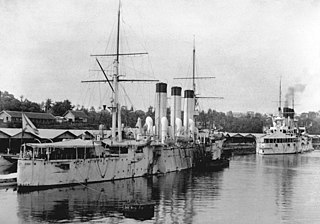 W
WDiana was the second of three Pallada-class protected cruisers built for the Imperial Russian Navy. The cruiser served during the Russo-Japanese War and took part in the Battle of the Yellow Sea on 10 August 1904. Later, she served as part of Russian Baltic Fleet during World War I.
 W
WDmitrii Donskoi was an armoured cruiser built for the Imperial Russian Navy in the early 1880s. She was designed as a commerce raider and equipped with a full suite of sails to economize on coal consumption. The ship spent the bulk of her career abroad, either in the Far East or in the Mediterranean.
 W
WEdinorog was one of 10 Uragan-class monitors built for the Imperial Russian Navy in the mid-1860s. The design was based on the American Passaic-class monitor, but was modified to suit Russian engines, guns and construction techniques. Spending her entire career with the Baltic Fleet, the ship was only active when the Gulf of Finland was not frozen, but very little is known about her service. She was struck from the Navy List in 1900, converted into a storage hulk for mines in 1912 and renamed Blokshiv No. 4. The ship survived World War II and was stricken in 1957, although her ultimate fate is unknown.
 W
WGangut was an Imperial Russian coast defense ship named after the Battle of Gangut. This ship was a scaled-down version of the Imperator Aleksandr II-class battleships
 W
WGeneral-Admiral Apraksin, sometimes transliterated as Apraxin, was a member of the Admiral Ushakov-class coastal defense ships of the Imperial Russian Navy. She was named after General Admiral Fyodor Matveyevich Apraksin, the first commander of Russian Baltic Fleet. She was one of eight Russian pre-dreadnought battleships captured by the Imperial Japanese Navy during the Russo-Japanese War of 1904-1905. She subsequently served in the Japanese Navy as Okinoshima (沖ノ島) until removed from service in 1922.
 W
WIlya Muromets, Russian designation Project 21180, is a Russian icebreaker built by Admiralty Shipyard in Saint Petersburg and commissioned on 30 November 2017. She is the first icebreaker built for the Russian Navy in almost 40 years.
 W
WImperator Nikolai I was a Russian Imperator Aleksandr II-class battleship built for the Baltic Fleet in the late 1880s. She participated in the celebration of the 400th anniversary of the discovery of America in New York City in 1892. She assigned to the Mediterranean Squadron and visited Toulon in October 1893. She sailed for the Pacific Ocean during the First Sino-Japanese War and remained in the Pacific until late 1896, when she returned to the Mediterranean Squadron and supported Russian interests during the Cretan Revolt. She returned to the Baltic in April 1898 and had a lengthy refit, which replaced all of her machinery, before returning to the Mediterranean in 1901.
 W
WProject 865 Piranha is a type of Russian midget submarine. The NATO reporting name for the class is Losos, which means "salmon" in the Russian language.
 W
WNavarin was a pre-dreadnought battleship built for the Imperial Russian Navy in the late 1880s and early 1890s. The ship was assigned to the Baltic Fleet and spent the early part of her career deployed in the Mediterranean and in the Far East. She participated in the suppression of the Boxer Rebellion in 1900 before returning to the Baltic Fleet in 1901. Several months after the beginning of the Russo-Japanese War in February 1904, she was assigned to the 2nd Pacific Squadron to relieve the Russian forces blockaded in Port Arthur. During the Battle of Tsushima in May 1905, she was sunk by Japanese destroyers which spread twenty-four linked mines across her path during the night. Navarin struck two of these mines and capsized with the loss of most of her crew.
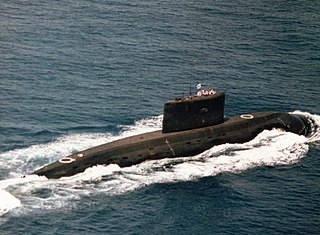 W
WIRIS Nooh is the second Kilo-class attack submarine of Islamic Republic of Iran Navy, serving in the Southern Fleet.
 W
WOleg was the 4th and final Bogatyr-class protected cruiser built for the Imperial Russian Navy.
 W
WKRI Irian, previously named Ordzhonikidze was a Sverdlov-class cruiser, Soviet designation Project 68bis of the Soviet Navy that was acquired by Indonesian Navy in the 1960s.
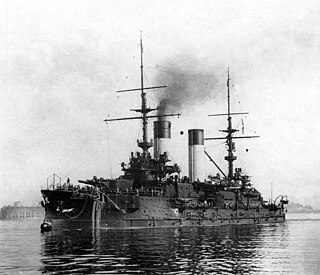 W
WOryol was a Borodino-class battleship built for the Imperial Russian Navy in the first decade of the 20th century. The ship was completed after the start of the Russo-Japanese War in February 1904 and was assigned to the Second Pacific Squadron sent to the Far East six months later to break the Japanese blockade of Port Arthur. The Japanese captured the port while the squadron was in transit and their destination was changed to Vladivostok. Oryol was badly damaged during the Battle of Tsushima in May 1905 and surrendered to the Japanese, who put her into service under the name of Iwami.
 W
WOslyabya was the second of the three Peresvet-class second-class pre-dreadnought battleships built for the Imperial Russian Navy at the end of the nineteenth century, although construction delays meant that she was the last to be completed. The ship was part of the Second Pacific Squadron sent to the Far East during the Russo-Japanese War of 1904–05, and served as the flagship of Rear Admiral Baron Dmitry von Fölkersam. Oslyabya was sunk on 27 May 1905 at the Battle of Tsushima, and was the first all-steel battleship to be sunk by naval gunfire alone. Sources differ on the exact number of casualties, but over half her crew went down with the ship.
 W
WPallada was the lead ship in the Pallada class of protected cruisers in the Imperial Russian Navy. She was built in the Admiralty Shipyard at Saint Petersburg, Russia. The new class was a major improvement on previous Russian cruisers, although the armor protection was light.
 W
WPallada was the last of the four Bayan-class armored cruisers built for the Imperial Russian Navy in the first decade of the 20th century. She was assigned to the Baltic Fleet during World War I where she captured codebooks from the German cruiser Magdeburg that had run aground during the first month of the war. The ship was torpedoed by a German submarine in October 1914 and exploded; none of the crew survived. Pallada was the first warship lost by the Russians during the war.
 W
WPetr Velikiy was an ironclad turret ship built for the Imperial Russian Navy during the 1870s. Her engines and boilers were defective, but were not replaced until 1881. The ship made a cruise to the Mediterranean after they were installed, and before returning to the Baltic Fleet, where she remained for the rest of her career. She did not, like the rest of the Baltic Fleet, participate in the Russo-Turkish War of 1877–1878. Petr Veliky was deemed obsolete by the late 1890s, but she was not ordered to be converted into a gunnery training ship until 1903.
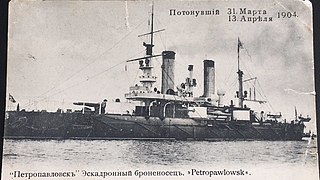 W
WPetropavlovsk was the lead ship of her class of three pre-dreadnought battleships built for the Imperial Russian Navy during the last decade of the 19th century. The ship was sent to the Far East almost immediately after entering service in 1899, where she participated in the suppression of the Boxer Rebellion the next year and was the flagship of the First Pacific Squadron.
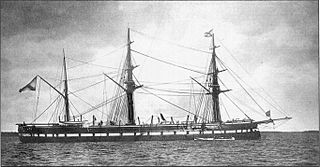 W
WThe Russian ironclad Petropavlovsk was a 22-gun armored frigate in the Imperial Russian Navy during the late 19th century. She was originally ordered as a 58-gun wooden frigate, but she was reordered as an ironclad while under construction and subsequently converted into one. She served as the flagship of the Baltic Fleet during the 1860s and 1870s. The ship was decommissioned in 1885, but was not sold for scrap until 1892.
 W
WThe Russian battleship Poltava was one of three Petropavlovsk-class pre-dreadnought battleships built for the Imperial Russian Navy in the 1890s. The ship was transferred to the Pacific Squadron shortly after completion and based at Port Arthur from 1901. During the Russo-Japanese War of 1904–1905, she participated in the Battle of Port Arthur and was heavily damaged during the Battle of the Yellow Sea. She was sunk by Japanese artillery during the subsequent Siege of Port Arthur in December 1904, but was raised by the Imperial Japanese Navy (IJN) after the war and renamed Tango (丹後).
 W
WPoltava was the second of the Gangut-class battleships of the Imperial Russian Navy built before World War I. The Ganguts were the first class of Russian dreadnoughts. She was named after the Russian victory over Charles XII of Sweden in the Battle of Poltava in 1709. She was completed during the winter of 1914–1915, but was not ready for combat until mid-1915. Her role was to defend the mouth of the Gulf of Finland against the Germans, who never tried to enter, so she spent her time training and providing cover for mine laying operations. She was laid up in 1918 for lack of trained crew and suffered a devastating fire the following year that almost gutted her. Many proposals were made to reconstruct or modernize her in different ways for the next twenty years, but none were carried out. While all this was being discussed she served as source of spare parts for her sister ships and was used as a barracks ship. She was finally struck from the Navy List in 1940 and scrapping began at a very leisurely rate. She was intentionally grounded in late 1941 to prevent her from being sunk in some inconvenient location by the Germans. She was refloated in 1944 and scrapped beginning in 1949.
 W
WProject 97 icebreakers and their derivatives are a diverse series of diesel-electric icebreakers and other icebreaking vessels built in the Soviet Union. In total, 32 vessels were built in various configurations for both civilian and naval service in the 1960s, 1970s and early 1980s, and several remain in service in Russia as of 2020.
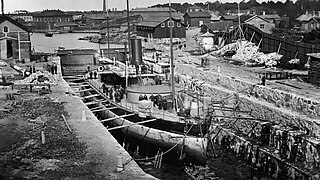 W
WRusalka, was one of two Charodeika-class monitors built for the Imperial Russian Navy in the 1860s. She served for her entire career with the Baltic Fleet. Aside from hitting an uncharted rock not long after she was completed in 1869, she had an uneventful career. Rusalka sank in a storm in 1893 with the loss of all hands in the Gulf of Finland. A memorial was built in Reval to commemorate her loss almost a decade later. Her wreck was rediscovered in 2003, bow-down in the mud, which has prompted a new theory regarding her loss.
 W
WB-585 Sankt Peterburg is the lead boat of the St. Petersburg class of the Russian Navy. The Lada class is the fourth generation of diesel-electric submarines designed and constructed in the former Soviet Union and Russia to replace the Kilo class. Construction of the boat started in December 1997, and she was launched in October 2004. After undergoing a series of sea trials, Sankt Peterburg was commissioned in May 2010. However, the Russian Navy decided not to accept the St. Petersburg class after it was discovered that the boat's propulsion and sonar systems were inadequate. After design corrections the submarine was accepted. In 2014, Sankt Peterburg joined the Northern Fleet.
 W
WSevastopol was the last of three ships in the Petropavlovsk class of pre-dreadnought battleships built for the Imperial Russian Navy in the 1890s.
 W
WINS Sindhukirti (S61) is the seventh Sindhughosh-class diesel-electric submarine of the Indian Navy. She was built at the Admiralty Shipyard and Sevmash in the Soviet Union.
 W
WINS Sindhurakshak was a Russian-made Kilo-class 877EKM (Sindhughosh-class) diesel-electric submarine of the Indian Navy. Commissioned on 24 December 1997, it was the ninth of the ten Kilo-class submarines in the Indian Navy. On 4 June 2010, the Indian Defence Ministry and Zvezdochka shipyard signed a contract worth US$80 million to upgrade and overhaul the submarine. After the overhaul, it returned to India from Russia between May and June 2013.
 W
WSissoi Veliky was a pre-dreadnought battleship built for the Imperial Russian Navy in the 1890s. The ship's construction was marred by organizational, logistical and engineering problems and dragged on for more than five years. She was commissioned in October 1896 with an appalling number of design and construction faults, and only a few of them were fixed during her lifetime. Immediately after sea trials, Sissoi Veliky sailed to the Mediterranean to enforce the naval blockade of Crete during the Greco-Turkish War. On March 15 [O.S. March 3], 1897 she suffered a devastating explosion of the aft gun turret that killed 21 men. After nine months in the docks of Toulon for repairs, the ship sailed to the Far East to reinforce the Russian presence there. In the summer of 1900, Sissoi Veliky supported the international campaign against the Boxer Rebellion in China. Sailors from Sissoi Veliky and the battleship Navarin participated in the defence of the International Legations in Beijing for more than two months.
 W
WSmerch was a monitor built for the Imperial Russian Navy in the early 1860s. She was designed by the British shipbuilder Charles Mitchell and built in Saint Petersburg. The ship spent her entire career with the Baltic Fleet. She ran aground and sank shortly after she entered service in 1865. Smerch was refloated and repaired shortly afterwards. She became a training ship sometime after 1892 and was stricken from the Navy List in 1904. The ship was hulked five years later and renamed Blokshiv No. 2. She was in Finland when that country declared its independence in 1918, but was returned to the Soviets after the Treaty of Brest-Litovsk was signed. Blokshiv No. 1, as the ship was now known, was sunk by German artillery fire in 1941. She was salvaged the following year and remained in service until she was stricken in 1959 and subsequently broken up.
 W
WTifon was an Uragan-class monitor built for the Imperial Russian Navy in the mid-1860s. The design was based on the American Passaic-class monitor, but was modified to suit Russian engines, guns and construction techniques. Spending her entire career with the Baltic Fleet, the ship was only active when the Gulf of Finland was not frozen, but very little is known about her service. She was struck from the Navy List in 1900, converted into a storage hulk for mines in 1909 and renamed Blokshiv No. 3. The ship was abandoned by the Soviets in Finland in 1918; although retroceded to the Soviets in 1922, she was later scrapped by the Finns.
 W
WTsugaru (津軽) was a protected cruiser of the Imperial Japanese Navy, acquired as a prize of war during the Russo-Japanese War from the Imperial Russian Navy, where it was originally known as Pallada. The cruisers Aurora and Diana were its sister ships.
 W
WUragan was the name ship of her class of 10 monitors built for the Imperial Russian Navy in the mid-1860s. The design was based on the American Passaic-class monitor, but was modified to suit Russian engines, guns and construction techniques. Spending her entire career with the Baltic Fleet, the ship was only active when the Gulf of Finland was not frozen, but very little is known about her service. She was stricken in 1900 from the Navy List, converted into a coal barge in 1903 and renamed Barzha No. 39, then Barzha No. 52 and finally Barzha No. 325. Abandoned by the Soviets in Finland in 1918, the ship was later scrapped by the Finns.
 W
WIRIS Younes or Yunes is the third Kilo-class attack submarine of Islamic Republic of Iran Navy serving in the Southern Fleet. The submarine is part of the 28th Flotilla.
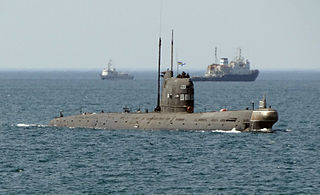 W
WZaporizhzhia (U-01) is a project 641 (Foxtrot-class) diesel-electric powered submarine, and was the only submarine of the Ukrainian Navy up until her seizure in March 2014 by Russian forces during 2014 Russian annexation of Crimea. She formerly carried the Soviet Navy pennant number B-435. Zaporizhzhia was designed at the Rubin Design Bureau.